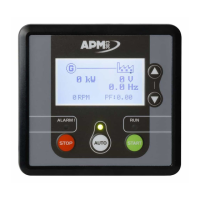APM303 - QUICK START GUIDE page 1/2
GS = Generating Set
ATS = Automatic Transfer Switch
Read the safety instructions on starting up
a GS.
(see General and Safety Manual)
When the GS is off, the control unit may be powered by a
dangerous voltage (preheating, battery charger).
When on, the APM303 is powered by a dangerous voltage.
The APM303
has been factory preconfigured; modifying its
parameters may make the generating set unstable.
Close the battery isolator (if fitted),
Turn the switch on the front of the central console ON (if fitted).
3 - Checks before starting
Engine oil level,
Coolant level,
GS circuit breaker open.
If the ALARM! LED is flashing, refer to section 7.
4 - Front panel, buttons and LEDs
stops the GS and
acknowledges the fault (if
ALARM!
is flashing)
selects AUTO or MANUAL
mode
(see section 13)
no anomaly (alarm or fault)
fault detected but cleared
anomaly detected (alarm or fault)
AUTO mode selected
on/engine cooling
GS started (
mode)
start or stop in progress
5 - Operation in MANUAL mode: GS on
MANUAL mode inhibits AUTO mode.
If the ALARM! LED is off (no fault present), it is possible to
start the GS.
Press the START button, the RUN LED flashes, the GS starts.
When the voltage and frequency have stabilised, the RUN LED
becomes fixed.
Manually close the GS circuit breaker; the GS takes load
or is ready to take load.
Check the electrical and mechanical values on the APM303
screens (see section 13).
5 - Operation in MANUAL mode: GS off
Manually open the GS circuit breaker (the power is cut
off).
Allow the engine to cool down for 3 minutes.
Press the STOP button, the RUN
stops.
6 - Operation in AUTO mode
The AUTO mode is active only if the AUTO LED is fixed.
Check that the GS circuit breaker is closed.
Press the AUTO button, the AUTO LED lights up, AUTO mode
is selected.
Start up is possible if the ALARM! LED is off.
Start-up is launched on activation of the remote start/stop,
input, which must be a () potential-free contact (no AC or DC
voltage).
() e.g. coming from a self-regulating ATS.
On activation of the input, the RUN LED flashes and the GS
starts.
When the voltage and frequency have stabilised, the RUN
LED becomes fixed and the GS takes over.
On deactivation of the remote start/stop input, the RUN LED
flashes.
After a cooling period (3 minutes) (), the GS stops and the
RUN LED goes off.
The AUTO
LED remains on, the GS is on standby, ready for
another start.
(
) If an ATS is fitted, the total number of cooling periods
must be correctly adjusted.
MANUAL mode takes priority over active AUTO mode:
- pressing the START button activates MANUAL mode,
- pressing the STOP button stops the GS.
7 - Appearance of an anomaly
If the ALARM! LED flashes (see section 13), this means that
an anomaly (alarm or fault) has been detected.
To view the anomaly, press or
below:
The anomaly appears with an order number
B
Pictogram symbolising the anomaly (see sections 9 and
11)
Anomaly status (fault only, see section 10)
D
Number of hours GS has been operating when anomaly
appeared
See section 13 when flashes
Note: this screen also shows the events (see section 12).
8 - Active and inactive alarm
An alarm cannot be cleared: it becomes inactive even after
intervention from the user.
LED off
LED on

